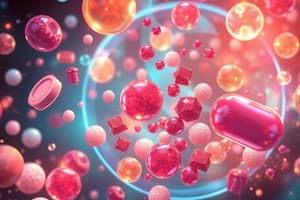Podcast
Questions and Answers
Which branch of pharmacology studies how drugs affect the body?
Which branch of pharmacology studies how drugs affect the body?
- Pharmaceutical Chemistry
- Toxicology
- Pharmacokinetics
- Pharmacodynamics (correct)
Pharmacokinetics is concerned with the harmful effects of drugs and chemicals.
Pharmacokinetics is concerned with the harmful effects of drugs and chemicals.
False (B)
What does the therapeutic index indicate?
What does the therapeutic index indicate?
Drug safety
The range of drug dosages which can treat disease effectively without causing significant side effects is known as the ______.
The range of drug dosages which can treat disease effectively without causing significant side effects is known as the ______.
Match the following drug administration routes with their descriptions:
Match the following drug administration routes with their descriptions:
Which type of adverse drug reaction is predictable and dose-dependent?
Which type of adverse drug reaction is predictable and dose-dependent?
Pharmacovigilance is focused on drug development.
Pharmacovigilance is focused on drug development.
Name one characteristic of personalized medicine.
Name one characteristic of personalized medicine.
Study Notes
Definitions
- Pharmacology: The study of drugs, their origins, chemical properties, biological effects, and therapeutic uses.
Branches of Pharmacology
- Pharmacodynamics: Studies how drugs affect the body.
- Pharmacokinetics: Examines how the body processes drugs, including absorption, distribution, metabolism, and excretion (ADME).
- Toxicology: Focuses on the harmful effects of drugs and other chemicals.
Drug Classification
- By Therapeutic Use: Analgesics, antibiotics, antidepressants, etc.
- By Mechanism of Action: Beta-blockers, ACE inhibitors, etc.
- By Source: Natural (plant, animal), synthetic, and semi-synthetic.
Key Concepts
- Dose-Response Relationship: The correlation between drug dosage and its effect on the body.
- Therapeutic Index: The ratio between the toxic dose and the therapeutic dose; indicates drug safety.
- Ex therapeutic window: The range of drug dosages which can treat disease effectively without causing significant side effects.
Drug Administration Routes
- Oral: Taken via mouth (tablets, capsules).
- Parenteral: Injection (IV, IM, subcutaneous).
- Topical: Applied to skin/mucous membranes.
- Inhalation: Breathed into the lungs.
Adverse Drug Reactions (ADRs)
- Types:
- Type A: Predictable and dose-dependent.
- Type B: Unpredictable and not related to dose.
- Common ADRs: Allergic reactions, gastrointestinal disturbances, CNS effects.
Drug Interactions
- Pharmacodynamic Interactions: When two drugs have additive or antagonistic effects.
- Pharmacokinetic Interactions: When one drug affects the absorption, distribution, metabolism, or excretion of another.
Clinical Pharmacology
- Drug Development: Stages include discovery, preclinical trials, clinical trials (Phases I-IV), and post-marketing surveillance.
- Personalized Medicine: Tailoring medical treatment to the individual characteristics of each patient, often based on genetic profiles.
Important Drug Categories
- Controlled Substances: Drugs that are regulated due to their potential for abuse (e.g., opioids, stimulants).
- Over-the-Counter (OTC) Medications: Drugs available without a prescription.
Pharmacovigilance
- The science of monitoring the safety of drugs after they have been released for general use, focusing on reducing risks and ensuring drug safety.
Pharmacology
- The study of drugs, encompassing their origins, chemical properties, biological effects, and therapeutic uses.
Branches of Pharmacology
- Pharmacodynamics studies how drugs impact the body.
- Pharmacokinetics examines how the body processes drugs, including absorption, distribution, metabolism, and excretion (ADME).
- Toxicology focuses on the harmful effects of drugs and other chemicals.
Drug Classification
- Drugs can be classified by their therapeutic use (e.g., analgesics, antibiotics, antidepressants).
- Classification by mechanism of action (e.g., beta-blockers, ACE inhibitors).
- Drugs can also be classified by their source, including natural (plant, animal), synthetic, and semi-synthetic origins.
Key Concepts
- Dose-Response Relationship: The correlation between the amount of drug given and its effect on the body.
- Therapeutic Index: The ratio between the toxic dose and the therapeutic dose, providing an indication of a drug's safety.
- Ex therapeutic window: The range of drug dosages which can treat disease effectively without causing significant side effects.
Drug Administration Routes
- Oral: Drugs taken by mouth (e.g., tablets, capsules).
- Parenteral: Drugs administered by injection (intravenous (IV), intramuscular (IM), subcutaneous).
- Topical: Drugs applied to the skin or mucous membranes.
- Inhalation: Drugs breathed into the lungs.
Adverse Drug Reactions (ADRs)
- Type A: Predictable and dose-dependent adverse reactions.
- Type B: Unpredictable adverse reactions not related to dose.
- Common ADRs: Allergic reactions, gastrointestinal disturbances, and central nervous system (CNS) effects.
Drug Interactions
- Pharmacodynamic Interactions: Occur when two drugs have additive or antagonistic effects.
- Pharmacokinetic Interactions: One drug affects the absorption, distribution, metabolism, or excretion of another.
Clinical Pharmacology
- Drug Development: Stages include discovery, preclinical trials, clinical trials (Phases I-IV), and post-marketing surveillance.
- Personalized Medicine: Tailoring medical treatment to individual patient characteristics, often based on genetic profiles.
Important Drug Categories
- Controlled Substances: Drugs regulated due to their potential for abuse (e.g., opioids, stimulants).
- Over-the-Counter (OTC) Medications: Drugs available without a prescription.
Pharmacovigilance
- The science of monitoring drug safety after release for general use, focusing on reducing risks and ensuring drug safety.
Studying That Suits You
Use AI to generate personalized quizzes and flashcards to suit your learning preferences.
Description
This quiz covers essential concepts in pharmacology, including the branches such as pharmacodynamics and pharmacokinetics, as well as drug classification and key principles like the dose-response relationship. Test your knowledge on therapeutic uses and the safety of various drugs.



